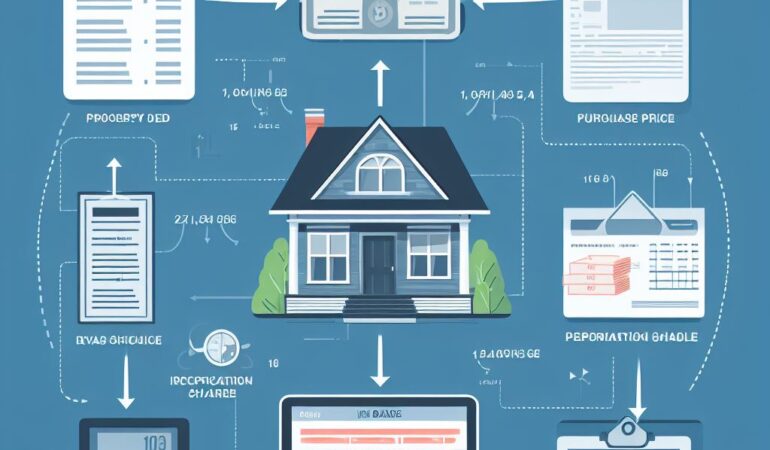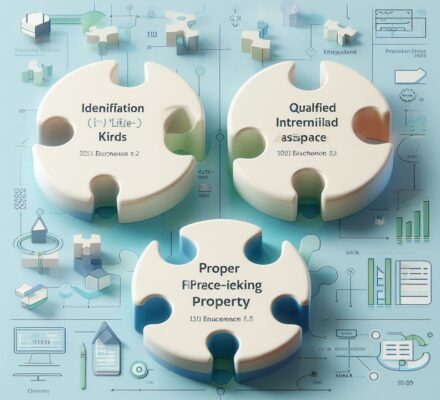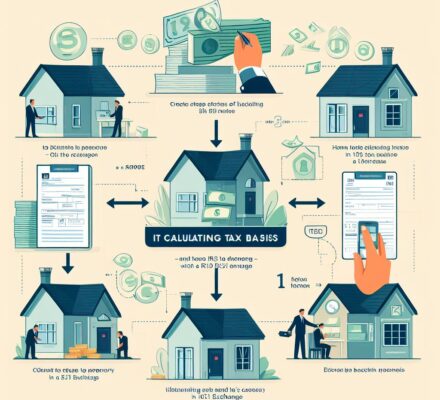Picture yourself embarking on a journey to navigate the intricacies of calculating tax basis for a 1031 exchange. With 13 essential steps at your fingertips, you’ll uncover the secrets to understanding tax basis, determining purchase prices, and accounting for capital improvements.
Prepare to calculate depreciation adjustments, assess fair market value, and adjust for casualty losses.
Consider deferred gains or losses and calculate the adjusted tax basis with expert guidance.
Get ready to take control of your financial future.
Key Takeaways
- Tax basis is the value of an asset for tax purposes and is crucial for determining potential gain or loss in a 1031 exchange.
- Accurate calculation of tax basis is important for depreciation recapture and involves factors such as purchase price, improvements, and depreciation.
- Determining the initial purchase price and capital improvements is essential, taking into account factors such as actual purchase price, additional acquisition costs, and adjustments for depreciation or improvements.
- Depreciation adjustments and tracking capital expenditures are crucial in a 1031 exchange, as recaptured depreciation can impact taxable income. Accurate record-keeping of capital improvements and detailed documentation of invoices, receipts, and contracts is necessary.
Understand the Concept of Tax Basis
To understand the concept of tax basis for a 1031 exchange, you need to familiarize yourself with the calculation methods involved. The tax basis refers to the value of an asset for tax purposes. It’s crucial because it determines the amount of potential gain or loss that you may incur during a 1031 exchange.
The tax basis is calculated by taking into account various factors such as the initial purchase price, improvements made to the property, and any depreciation taken. It’s important to note that the tax basis can be adjusted over time due to events like improvements or depreciation.
Understanding the tax basis is essential because it helps you determine whether your exchange will result in a taxable gain, loss, or if it will be tax-deferred. Additionally, it allows you to accurately calculate the amount of depreciation that will be recaptured upon the sale of the property.
Now that you understand the concept of tax basis, let’s move on to the next step, which is determining the initial purchase price.
Determine the Initial Purchase Price
Calculating the initial purchase price is a crucial step in determining the tax basis for a 1031 exchange. The initial purchase price refers to the amount of money you paid to acquire the property that you are now looking to exchange. This price will serve as the starting point for calculating your tax basis, which is essential for determining any potential capital gains or losses.
To accurately determine the initial purchase price, you need to consider several factors. These include the actual purchase price of the property, any additional costs incurred during the acquisition process, and any adjustments made for depreciation or improvements. It’s important to gather all the necessary documentation, such as purchase agreements, closing statements, and receipts, to ensure an accurate calculation.
To make it easier for you to understand, here is a table outlining the components of the initial purchase price:
| Component | Description |
|---|---|
| Purchase Price | The actual amount paid to acquire the property. |
| Acquisition Costs | Additional expenses incurred during the acquisition process, such as attorney fees or inspection costs. |
| Depreciation | Any adjustments made for the depreciation of the property. |
| Improvements | Any costs associated with improving or renovating the property. |
Account for Capital Improvements
When accounting for capital improvements in a 1031 exchange, there are several important points to consider.
First, you need to keep track of any renovations and repairs made to the property, as these expenses can be included in your tax basis.
Additionally, the cost of improvements, such as adding a new wing or upgrading the plumbing, should also be factored in.
Lastly, it’s crucial to maintain accurate records of all capital expenditures, including receipts and invoices, to ensure proper documentation for tax purposes.
Renovations and Repairs
Make sure you account for capital improvements by factoring in renovations and repairs during your tax basis calculation for a 1031 exchange.
Renovations and repairs refer to any improvements made to the property that enhance its value or extend its useful life. These improvements can include anything from replacing the roof, updating the plumbing and electrical systems, to remodeling the kitchen or bathroom.
When calculating your tax basis, it’s important to distinguish between ordinary repairs and capital improvements. Ordinary repairs are deducted as expenses in the year they’re incurred, while capital improvements are added to the basis of the property.
Cost of Improvements
To accurately calculate your tax basis for a 1031 exchange, it’s crucial to factor in the cost of improvements, specifically capital improvements. These are significant enhancements made to a property that increase its value or extend its useful life. When determining the tax basis, consider the following:
- Capital Improvements: These are major upgrades to the property, such as adding a new roof, renovating the kitchen, or expanding the living space. Include the total cost of these improvements in your tax basis calculation.
- Improvement Documentation: Keep detailed records of all improvements made, including receipts, invoices, and contracts. This documentation will be essential when determining the adjusted basis of the property and justifying the increase in value.
Tracking Capital Expenditures
To accurately account for capital improvements and track capital expenditures in a 1031 exchange, you need to diligently record all relevant documentation. This includes invoices, receipts, contracts, and any other paperwork related to the improvements made on the property.
It’s essential to keep a detailed record of the costs incurred for each improvement, as well as any expenses related to the construction or renovation process. By doing so, you’ll have a clear and accurate account of the capital expenditures, which will be crucial when calculating the tax basis for your 1031 exchange.
Properly tracking these investments will ensure that you can take advantage of any tax benefits associated with capital improvements.
Now, let’s move on to the next step: calculating depreciation adjustments.
Calculate Depreciation Adjustments
To properly calculate depreciation adjustments for a 1031 exchange, there are a few points you need to consider.
First, you must understand the tax implications of recaptured depreciation, as it can impact your taxable income.
Next, you should identify all depreciable assets associated with the property being exchanged.
Finally, you’ll need to calculate the adjusted tax basis by subtracting the total depreciation taken from the original cost basis.
Recaptured Depreciation Tax Implications
When calculating depreciation adjustments for recaptured depreciation tax implications in a 1031 exchange, you need to take into account the original cost basis of the property. This is crucial in determining the amount of recaptured depreciation that will be subject to taxation.
Here are the essential steps to calculate depreciation adjustments:
- Determine the original cost basis of the property: This includes the purchase price of the property, plus any additional costs such as closing fees and legal expenses.
- Calculate the total depreciation taken: This involves determining the total amount of depreciation that has been claimed on the property over the years.
- Determine the adjusted basis: Subtract the total depreciation taken from the original cost basis to arrive at the adjusted basis.
- Calculate the recaptured depreciation: Multiply the recaptured depreciation rate (currently 25%) by the adjusted basis to calculate the amount of depreciation that will be subject to taxation.
Identifying Depreciable Assets
To accurately calculate depreciation adjustments for recaptured depreciation tax implications in a 1031 exchange, it is important to identify the depreciable assets involved in the transaction. These assets include property improvements, machinery, vehicles, and furniture. By determining the tax basis of each depreciable asset, you can calculate the depreciation adjustments that need to be made.
To help you better understand this process, let’s take a look at the following table:
| Depreciable Asset | Tax Basis |
|---|---|
| Property Improvements | $50,000 |
| Machinery | $30,000 |
| Vehicles | $20,000 |
| Furniture | $10,000 |
In this example, the tax basis for property improvements is $50,000, machinery is $30,000, vehicles is $20,000, and furniture is $10,000. These figures will be used to determine the depreciation adjustments for each asset.
Calculating Adjusted Tax Basis
Now, let’s dive into calculating the adjusted tax basis for your 1031 exchange by determining the depreciation adjustments for each depreciable asset involved in the transaction.
To accurately calculate the adjusted tax basis, you need to consider two key factors:
- Depreciation Method: Determine the depreciation method used for each depreciable asset. This can include methods such as straight-line, declining balance, or units of production.
- Depreciation Period: Identify the depreciation period for each asset. The period can vary based on the asset’s useful life, which is determined by the IRS guidelines.
By understanding the depreciation method and period for each asset, you can calculate the depreciation adjustments needed to determine the adjusted tax basis for your 1031 exchange.
This is a crucial step in ensuring the accuracy of your tax calculations and maximizing the benefits of your exchange.
Assess the Fair Market Value
To accurately assess the fair market value for your 1031 exchange, you must carefully evaluate the current market conditions and gather relevant information. The fair market value is the price at which a property would sell between a willing buyer and a willing seller, both being knowledgeable about the property and its condition, and neither being under any compulsion to buy or sell.
To determine the fair market value, you can start by researching recent sales of similar properties in the area. Look for comparable properties that are similar in size, location, and condition. Take note of any differences between the properties, such as upgrades or renovations, as these can affect the value.
You can also consult with real estate professionals or appraisers to get their expert opinion on the fair market value. Additionally, consider factors such as market trends, economic conditions, and the demand for properties in the area.
Identify Qualifying Expenses
When it comes to identifying qualifying expenses for a 1031 exchange, there are a few important points to consider.
First, you need to understand what expenses are allowable and deductible.
Second, it’s crucial to be aware of the non-qualifying expenses list, which includes items that can’t be considered as part of the exchange.
Lastly, implementing effective tracking and documentation methods is essential to ensure accuracy and compliance throughout the process.
Allowable Deductible Expenses
Your qualifying expenses play a crucial role in determining your tax basis for a 1031 exchange. To ensure that you’re accurately calculating your tax basis, it’s important to identify and include all allowable deductible expenses.
Here are some qualifying expenses you should consider:
- Direct acquisition costs:
- Purchase price
- Closing costs, such as title insurance and attorney fees
- Brokerage commissions
- Indirect acquisition costs:
- Property inspections and appraisals
- Escrow fees
- Recording fees
Non-Qualifying Expenses List
Consider the following expenses that do not qualify and make sure to identify the qualifying expenses for your tax basis calculation in a 1031 exchange. To help you understand which expenses qualify and which do not, refer to the table below:
| Non-Qualifying Expenses | Qualifying Expenses |
|---|---|
| Personal expenses | Acquisition costs |
| Home improvements | Property taxes |
| Repairs and maintenance | Insurance premiums |
| Depreciation of personal property | Legal and accounting fees |
| Closing costs on the sale of a property | Mortgage interest |
| Real estate commissions | Transfer taxes |
By knowing the non-qualifying expenses, you can exclude them from your tax basis calculation and focus on the qualifying expenses. This will help you accurately determine your tax liability and ensure compliance with the 1031 exchange rules.
Now that you are familiar with the non-qualifying and qualifying expenses, let’s move on to the next section, which covers tracking and documentation methods for your 1031 exchange.
Tracking and Documentation Methods
To effectively identify qualifying expenses for your tax basis calculation in a 1031 exchange, it’s essential to establish efficient tracking and documentation methods. By implementing these methods, you can accurately determine which expenses can be included in your tax basis calculation and potentially reduce your tax liability.
Here are two sub-lists outlining key steps to consider:
Tracking Methods:
- Maintain a separate account or ledger to track all expenses related to the property.
- Use accounting software or spreadsheets to record and categorize expenses for easy reference.
Documentation Methods:
- Keep all receipts, invoices, and other supporting documents organized and readily accessible.
- Create a system for labeling and storing physical and digital documents to ensure easy retrieval.
Include Transaction Costs
Include transaction costs in your calculation of tax basis for a 1031 exchange. When determining the tax basis, it’s crucial to take into account any expenses incurred during the exchange process. Transaction costs refer to fees, commissions, and other expenses directly related to the exchange transaction. These costs reduce the overall gain realized from the exchange and can be subtracted from the total sales price to arrive at the adjusted basis. Examples of transaction costs include brokerage fees, legal fees, title insurance, and escrow fees. Be sure to gather all relevant documentation to support these expenses and include them in your calculations accurately.
By including transaction costs in your tax basis calculation, you ensure an accurate reflection of your actual investment. This will help you determine the taxable gain or loss from the exchange accurately.
Now that we’ve discussed the importance of including transaction costs, it’s time to move on to the next step in calculating tax basis for a 1031 exchange: excluding personal expenses.
Exclude Personal Expenses
To accurately calculate the tax basis for a 1031 exchange, it’s important to exclude any personal expenses from your calculations. Personal expenses are costs incurred for your own personal benefit and aren’t related to the property being exchanged.
Here are some important points to consider when excluding personal expenses:
- Maintenance and Repairs: Exclude any expenses related to routine maintenance and repairs that aren’t directly tied to the property’s value. This includes things like painting, landscaping, and general upkeep.
- Personal Use: If you have used the property for personal purposes, such as a vacation home, you need to exclude any expenses associated with that personal use. This could include utilities, property taxes, or any other costs incurred during your personal occupancy.
By excluding personal expenses from your calculations, you ensure that only the relevant costs associated with the investment property are considered. This will help you accurately determine the tax basis for your 1031 exchange and avoid any discrepancies in your calculations.
Now that you understand the importance of excluding personal expenses, the next step is to factor in insurance proceeds.
Factor in Insurance Proceeds
Start by considering the insurance proceeds when calculating the tax basis for your 1031 exchange. Insurance proceeds refer to the money you receive from an insurance claim for any damages or losses to your property. These proceeds can have a significant impact on your tax basis calculation.
When you experience a loss due to fire, theft, or other covered events, insurance companies will often reimburse you for the damages. This reimbursement is considered as insurance proceeds. When calculating the tax basis for your 1031 exchange, you need to factor in these proceeds.
To determine the adjusted tax basis of your replacement property, you should subtract the insurance proceeds received from the cost of acquiring the replacement property. The adjusted tax basis is the value that will be used to calculate any potential taxable gain or loss upon the sale of the replacement property.
It is essential to accurately account for insurance proceeds when calculating the tax basis for your 1031 exchange. Failure to do so may result in miscalculations and potential tax liabilities. Consult a tax professional or advisor to ensure you correctly factor in the insurance proceeds and accurately determine your tax basis for the exchange.
Adjust for Casualty Losses
Factor in any casualty losses when calculating the tax basis for your 1031 exchange. Casualty losses refer to damages or destruction of your property due to events like fires, floods, or natural disasters. These losses can significantly impact the tax basis of your property and shouldn’t be overlooked.
Here are some important considerations when adjusting for casualty losses in your 1031 exchange:
- Determine the extent of the casualty loss: Assess the damage caused to your property and calculate the loss incurred. This includes considering the decrease in the fair market value of the property due to the casualty event.
- Subtract insurance reimbursements: If you received insurance proceeds to cover the casualty loss, subtract the amount you received from the overall loss. Insurance reimbursements can help offset the impact of the casualty event on your tax basis.
- Document the casualty loss: Keep detailed records of the casualty event, including photographs, repair estimates, and any other relevant documentation. This will help support your claim and ensure accuracy when calculating the adjusted tax basis for your 1031 exchange.
- Consult a tax professional: When dealing with casualty losses and their impact on your tax basis, it’s recommended to seek guidance from a tax professional or accountant. They can provide expert advice tailored to your specific situation and help ensure compliance with IRS rules and regulations.
Taking into account casualty losses is crucial when calculating the tax basis for your 1031 exchange. By properly adjusting for these losses, you can accurately determine the taxable gain or loss on your property exchange and avoid any unnecessary tax liabilities.
Consider Deferred Gains or Losses
After considering casualty losses, you should now consider any deferred gains or losses when calculating the tax basis for your 1031 exchange. Deferred gains or losses are those that have been postponed or delayed in recognition for tax purposes. For example, if you sold a property in the past and deferred the gain by reinvesting it in another property through a 1031 exchange, you’ll need to account for that deferred gain when calculating your tax basis.
To calculate the tax basis, you should start with the original cost of the property you sold, and then adjust it for any improvements or additions made to the property. Next, subtract any depreciation deductions taken over the years. This will give you the adjusted tax basis.
If you deferred a gain from a previous exchange, you’ll need to add that deferred gain to the adjusted tax basis. On the other hand, if you deferred a loss, you’ll need to subtract that deferred loss from the adjusted tax basis.
Calculate the Adjusted Tax Basis
To determine the adjusted tax basis for your 1031 exchange, calculate the total cost of the property sold and make adjustments for improvements, additions, and depreciation deductions taken over the years.
Here are the essential steps to calculate the adjusted tax basis:
- Calculate the total cost of the property sold: This includes the original purchase price, closing costs, and any other expenses directly related to the acquisition of the property.
- Account for improvements and additions: If you have made any improvements or additions to the property, such as renovating the kitchen or adding a new wing, you need to add the costs of these improvements to the adjusted tax basis.
- Consider depreciation deductions: If you have claimed depreciation deductions for the property over the years, you need to subtract the total amount of depreciation from the adjusted tax basis.
By following these steps, you can accurately determine the adjusted tax basis for your 1031 exchange, which is crucial for calculating any potential capital gains or losses.
Seek Professional Guidance if Needed
If you find the process of calculating the adjusted tax basis for your 1031 exchange to be complex or overwhelming, it’s advisable to seek professional guidance. A qualified tax professional can provide you with expert advice and assistance to ensure that you accurately determine the tax basis for your exchange. They’ve the knowledge and experience to navigate the intricacies of the tax code and help you make informed decisions.
When choosing a tax professional, look for someone who specializes in 1031 exchanges and has a thorough understanding of the relevant tax laws and regulations. They should have a track record of successfully assisting clients with similar transactions. It’s also important to consider their reputation and credentials to ensure that you’re working with a trustworthy and reliable advisor.
Seeking professional guidance can help you avoid costly mistakes and potential audits from the IRS. By relying on the expertise of a tax professional, you can have peace of mind knowing that your tax basis calculations are accurate and in compliance with the law. They can also provide valuable insights and strategies to maximize your tax savings and ensure a smooth and successful 1031 exchange.
Frequently Asked Questions
Can I Include Personal Expenses in the Calculation of Tax Basis for a 1031 Exchange?
No, you cannot include personal expenses in the calculation of tax basis for a 1031 exchange. Only qualifying business or investment expenses can be included to determine the tax basis for the exchange.
How Do I Account for Casualty Losses When Calculating the Adjusted Tax Basis?
Calculating the adjusted tax basis involves accounting for casualty losses. Consider the cost of repairs or insurance payments made due to the loss. Subtract these expenses from the original tax basis to determine the adjusted tax basis.
What Are Some Examples of Qualifying Expenses That Can Be Included in the Tax Basis Calculation?
To calculate the tax basis for a 1031 exchange, you need to consider qualifying expenses. Examples include purchase price, closing costs, improvements, and depreciation. These expenses can be included in your tax basis calculation.
Do I Need to Factor in Insurance Proceeds When Determining the Adjusted Tax Basis?
Yes, you need to factor in insurance proceeds when determining the adjusted tax basis. They can affect the cost basis of your property and may impact your tax liability.
When Should I Consider Seeking Professional Guidance for Calculating the Tax Basis for a 1031 Exchange?
You should consider seeking professional guidance for calculating the tax basis for a 1031 exchange when you have complex transactions, multiple properties, or are unsure about the rules and regulations.




